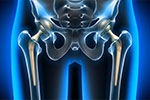Proximal hamstring tears are painful injuries that occur to just about anyone. However, studies indicate that those in athletics and those considered middle-aged are more likely to be affected by this condition. With research showing the prevalence of these injuries ranging between 8% and 25%, there is clearly a need for more information on proximal hamstring tears, symptoms, and treatment options.
What Is a Proximal Hamstring Tear?
A proximal hamstring tear is an injury to the proximal hamstring tendon, which attaches the hamstring muscle to the ischial tuberosity of the pelvis. Simply put, the hamstring tendon (located on the back of your thigh) attaches to the large pelvic bone you feel when you sit down.
This muscle is one of the most critical muscles in the lower body as it is responsible for flexing the hip joint and extending the knee joint. A proximal hamstring tear hinders your walking ability and can lead to chronic pain if not attended to quickly.
What Causes a Proximal Hamstring Tear?
A proximal hamstring tear typically occurs during strenuous physical activities, such as running or sprinting, and is usually caused by intense overload or overstretching of the tendon. Symptoms of a proximal hamstring tear include pain in the back of the thigh, swelling, and reduced range of motion in the affected area.
When determining the severity of a proximal hamstring tear, your orthopedic specialist evaluates the injury and gives it a grade based on the symptoms and severity. There are three grades of proximal hamstring tears:
- Grade 1: The most common proximal hamstring tear, often associated with only mild pain or swelling and little to no loss of function.
- Grade 2: The second most common tear, associated with some loss of function due to partial tear of the tissue causing moderate pain and swelling. There may be some bruising in the area as well.
- Grade 3: The most severe grade of a proximal hamstring tear indicated by a full tear of the tissue (also known as a complete proximal hamstring tendon avulsion) causing extreme pain, swelling, and loss of function. Significant bruising is very common with Grade 3 injuries.
How Does a Proximal Hamstring Tear Affect the Rest of the Body?
Since the proximal hamstring tendon is responsible for mobilizing the hip and knee joints, giving you the ability to stand, walk, run, and perform other daily activities, a proximal hamstring tear can be very debilitating.
If a tear isn't identified and treated early on, it may lead to long-term issues and chronic pain. The proximal hamstring tendon is also responsible for keeping your hips aligned. If a tear isn't identified and treated right away, it leads to other musculoskeletal issues, including hip impingement, knee instability, and even lower back pain.
Proximal Hamstring Tear Symptoms
While proximal hamstring tendon tear symptoms vary by patient, some common symptoms help you identify the issue sooner rather than later, ensuring you get the treatment you need right away:
- Bruising in the area
- Pain and tenderness in the back of your thigh
- Poor leg control/coordination
- Sharp pain that gets worse with activity
- Thigh cramps
- Weakness in the affected leg
These injuries usually begin with sharp pain in the back of the thigh, sometimes associated with an audible "pop" sound. If the pain is minor but gets worse with movement, you likely have a Grade 1 or 2 tear. However, if you're experiencing sharp pain and can't move your leg at all, or you're experiencing cramping with poor leg control, you may be suffering from a Grade 3 tear.
It doesn't matter how severe you think your injury is, it’s best to get it looked at immediately to avoid further damage to the tendon and more severe problems down the road.
How Are Proximal Hamstring Tear Symptoms Addressed?
Identifying proximal hamstring tendon tear symptoms is a crucial first step in getting the proper treatment. Depending on the severity of your injury, you may be treated with the following:
Physical Therapy
A more conservative approach to treating minor proximal hamstring tendon tears and is typically used to reduce pain and improve range of motion, flexibility, and strength.
Endoscopic Surgery
This is an effective and minimally invasive procedure for treating minor proximal hamstring tendon tears. During this procedure, a camera is inserted through a small incision in the skin, and the surgeon uses special instruments to repair the tendon.
Open Hamstring Repair Surgery
This surgery is more invasive to treat severe proximal hamstring tears. It involves making an incision in the leg to access and repair the tendon with sutures. After the surgery, physical therapy is typically recommended to restore strength, range of motion, and flexibility to the affected leg.
Have Your Proximal Hamstring Tear Symptoms Checked Right Away
Having any proximal hamstring tear symptoms checked by an orthopedic surgeon as soon as possible is vital. Early diagnosis and treatment reduce the risk of further injury and allow for a quicker recovery. Dr. Domb is an expert in Sports Medicine and Hip Arthroscopy and provides the best care for your proximal hamstring tear injury.
Request your appointment with Dr. Domb today.





